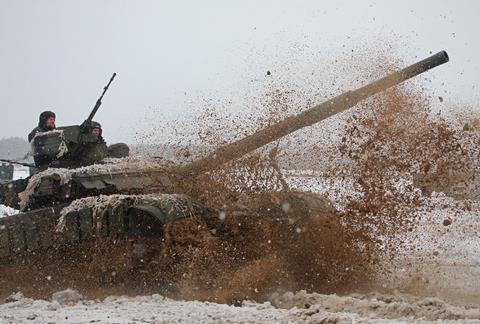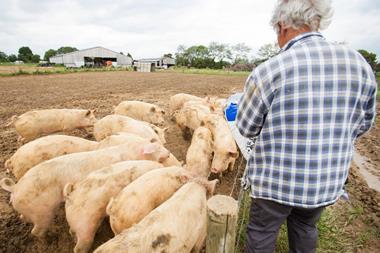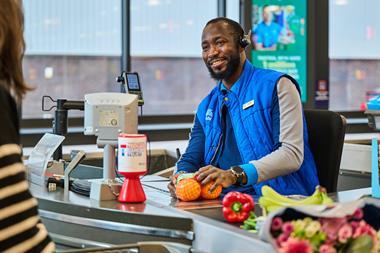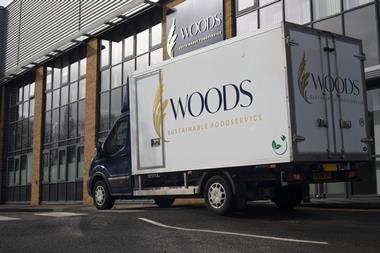
Despite whispers of diplomatic progress between Ukraine and Russia the situation on the ground remains dangerous for farmers across vast swathes of a country known as Europe’s breadbasket.
“There are a lot of mines, it is dangerous for people, there are a lot of Russians, some killed in the fields,” said Dr Alex Lissitsa, CEO of agribusiness IMC, which grazes dairy cows and grows fodder crops, sunflowers and corn across 120,000 hectares of northern and central Ukraine.
“There are a lot of bombs – yesterday our storage for plant protection was bombed,” Lissitsa said. “I have no idea right now what’s there.”
The invading Russian army has become noticeably more aggressive as its advance stalls, not only in cities but in farming regions far from the encircled capital of Kyiv, according to Lissitsa.
“The brutality of the Russian solders has increased in the last few days,” he said, accusing troops of firing into houses and laying mines on roads criss-crossing the country’s farmland, which at an estimated 30 million hectares takes up a land area exceeding the entire UK.
“The only thing I can do right now is help people leave the farm or help them to stay safe,” Lissitsa said.
Last week Ukraine president Volodymyr Zelenskyy vowed spring planting would proceed across the country, a defiant vow that sounded more of hope than expectation, at least in the east and north, close to the borders with Russia and Belarus.
According to Lissitsa, damage to farm infrastructure in northern and eastern regions meant a quick resumption of normal service would be difficult “even if the war ended tomorrow”.
“The western part of the country is more or less able to cultivate the land,” Lissitsa said. “If nothing happens over the next days they should be able to plant their summer crops and fertilise winter crops.”
But even that grain of optimism, which was based on the Russians not pushing west toward Ukraine’s frontiers with EU and NATO member states, would likely have little impact on rampant worldwide fuel and food price rises.
The inflation surge since 2020 was mostly caused by pandemic restrictions and labour shortages in the supply chain, but the invasion by Russia, the world’s biggest wheat and fertiliser exporter, of its neighbour, the world’s biggest source of sunflower oil and a top exporter of corn and wheat, has accelerated this.
The US Department of Agriculture last week predicted the war and sanctions on Russia would remove seven million tonnes of wheat from the world market this year, while the Food and Agriculture Organisation (FAO) of the UN forecast that “between 20%-30% of the areas under winter cereals, maize and sunflower seed in Ukraine will either not be planted or remain unharvested during the 2022/23 season”.
There were “a lot of unknowns around spring sowing and fieldwork, whether the Ukrainian harvest will be disrupted and further potential crop losses from the Russian invasion”, the AHDB’s Anthony Speight wrote in a Wednesday market update.
“Countries as far afield as Nigeria, Yemen and Bangladesh are already feeling the effects of reduced grain exports,” said Peter Ceretti, senior analyst with political risk analysts Eurasia Group.
“But the knock-on effects could be much worse: soaring fertiliser prices, export bans, and a failed planting season in Ukraine could all mean that millions around the world go hungry,” Ceretti warned in a note published on Wednesday.
“Apart from Ukraine itself,” according to Thijs Geijer, agriculture economist at Dutch bank ING, “the most pressing issues regarding food security arise in the Middle East”.
Lissitsa said IMC exports almost all of the wheat and corn it grows, much of it across the Black Sea and onwards to the Middle East and North Africa.
“Ninety per cent of Ukrainian agriculture exports go through Black Sea ports,” Lissitsa said, meaning even if western regions can harvest this year, it could be difficult to sell abroad, with the ports closed due to the war and shipping companies wary of coming too close to Russia’s Black Sea navy.
The volumes usually exported by sea could overwhelm railway lines, while consignments would have to be unloaded and reloaded at Ukraine’s borders due to differing gauges to Poland’s and Hungary’s. “Can you imagine [how] to export by railway 50 million tons of grains?” Lissitsa said.
Although western allies rejected the Ukraine government’s request for a so-called “no-fly zone” over the country, Lissitsa added friendly nations could do more to help its vital but war-wracked agriculture sector.
“We need to create a special kind of financial support for Ukrainian farmers. Ukrainian banks now do not have much money” to support purchases of increasingly pricey and hard-to-get inputs such as fertiliser.
And while the country had enough grains and oilseeds stockpiled to cover three to fours years of domestic consumption, according to Taras Vysotsky, first deputy minister of agrarian policy and food, the country had only 20% of the fuel it needed for agriculture, Lissitsa warned.
But first there remained a war to fight and land to defend.
Lissitsa said many of the 2,000 people who worked on IMC farmland in peacetime had since been deployed in some way for the Ukrainian army or government.
“Most of them have been mobilised,” he added.


















